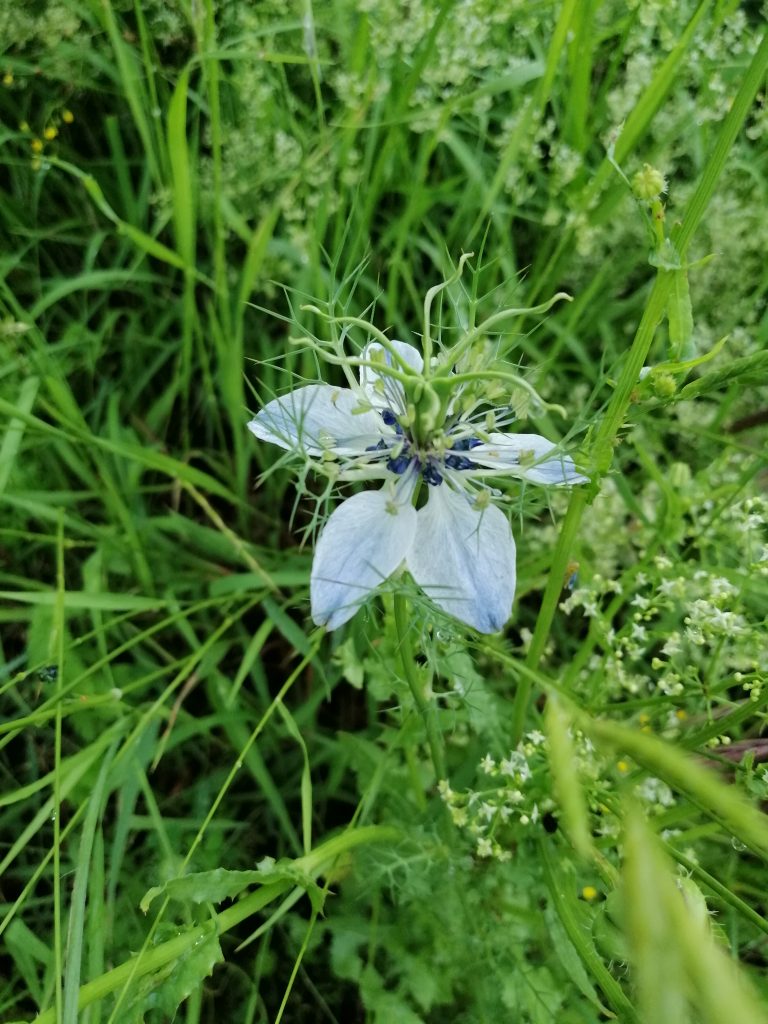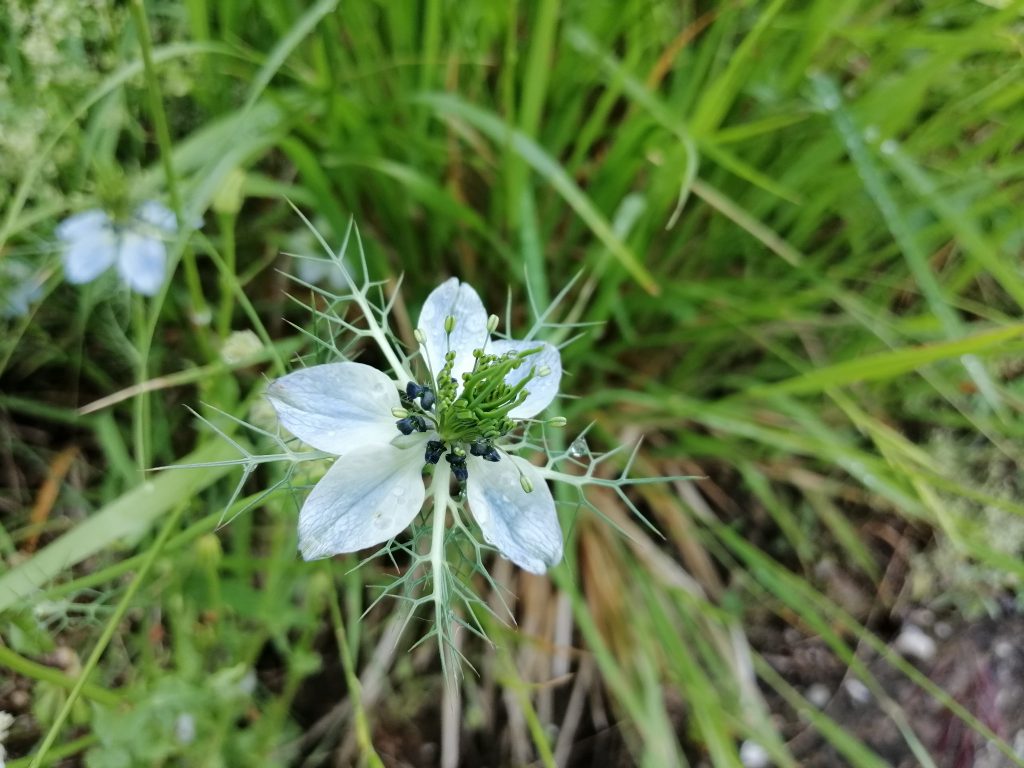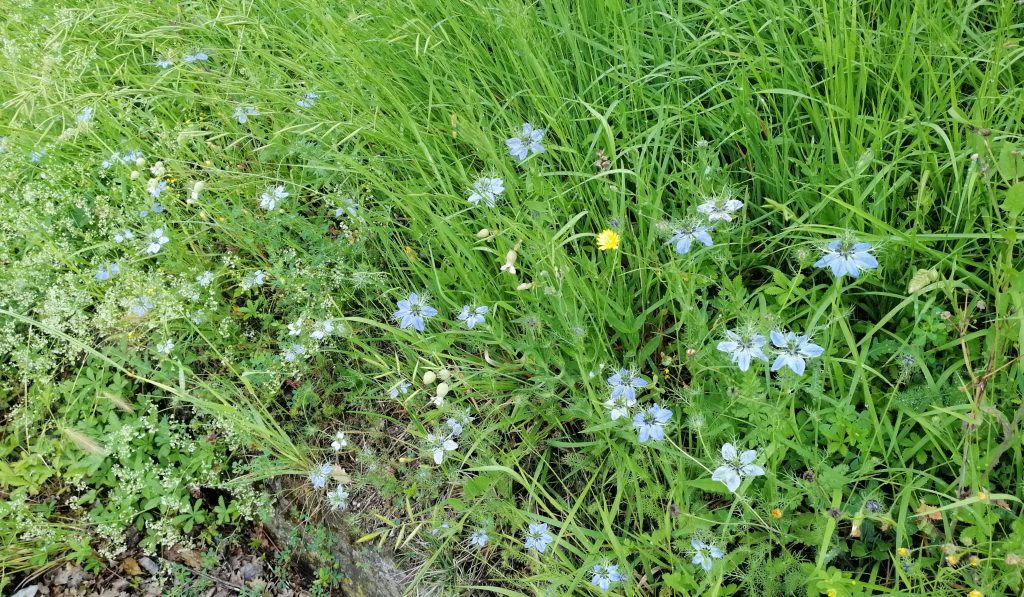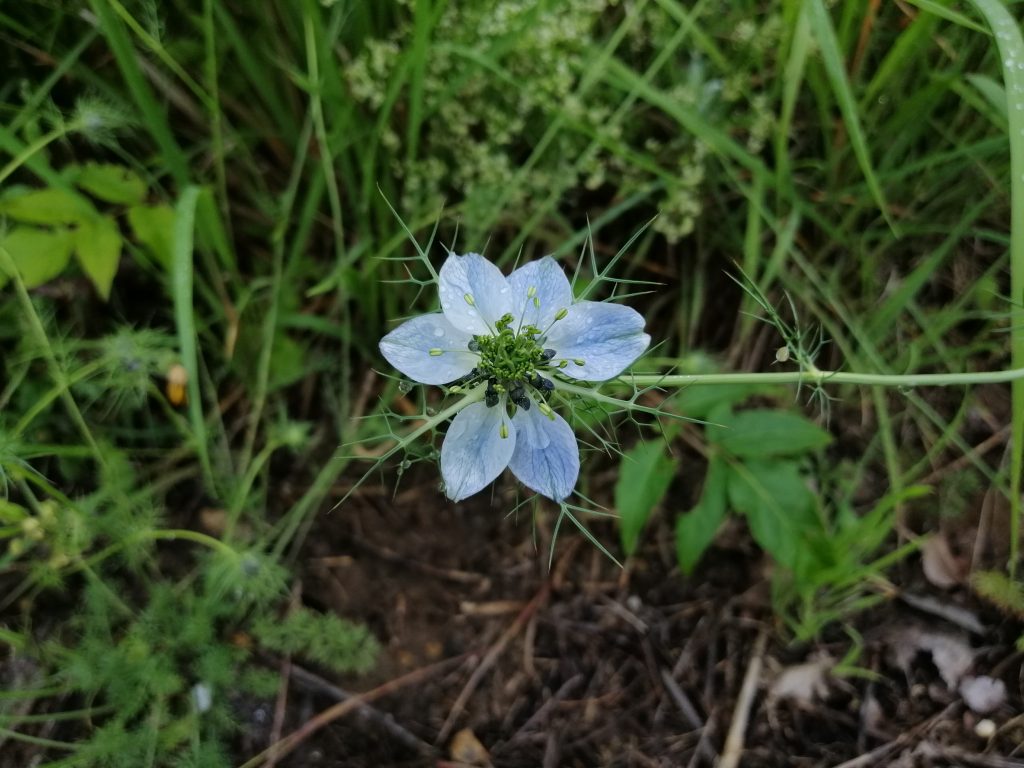
Botanical name: Nigella damascena L.
Common names: Love-in-a-Mist, ragged lady, devil in a bush; ancient: melanthion (Greek), gith.
Each time I meet this plant, my gaze is rapt by its beauty and the complexity of its figure. Even if it’s relatively common in the Mediterranean area, in practice it is met not so often. It usually appears in a group: sometimes a small piece of land or of a roadside appear as “grasped” by these plants and covered with spots of the almost ethereal color, that goes from the lightest to the deepest blue, of their flowers.
Looking at them, we cannot but notice immediately the very peculiar shapes of their leaves, flowers and also of the capsules containing the seeds. The shaping processes seem to affect love-in-a-mist in an “intense” and peculiar manner. These plants almost look as coming from another world, from a higher dimension, or from that sky their flowers seem to have stolen the color from and seem to have landed just there, on the piece of land they have rooted on.
The “poisonous” processes that, within this plant family (it belongs to the Ranunculaceae), tend to produce acrid and strongly toxic substances (let’s think to the deadly monkshood or to the hellebore, plant of mads and witches) seem to “grasp” these plants only partially, causing the production of substances with reduced toxicity but that are strongly medicinal (like the damascenine alkaloid contained in their seeds). Indeed, despite various authors describe them as being toxic or strongly toxic plants, their actual toxicity is quite low, so much that their seeds can be used as a spice.
So, love-in-a-mist is a “halfway” plant, suspended between the Earth and the Sky, between being food and poison, between the physical and the spirit worlds, and that seems to act as a bridge between these polarities (is the “crow-black” color of its seeds meaningful?). Probably it is no coincidence that Hadith reports that Mohammed, speaking of its congener species Nigella sativa, told that its black seeds (more known as black cumin or kalonji) are able to “cure all diseases but death”.
The love-in-a-mist seeds have a characteristic complex fruity odor that reminds the smell of wild strawberries, but they are bitter tasting. They can yield an absolute (essence) with a rich, sweet fruity (wild strawberry-grape complex), ambery bouquet with a fine ethereal, warm, honey, floral undertone [GoodScent]. Its rich fruity smell with ambery, floral accents provides a fine exotic bouquet of outstanding persistence.
The love-in-a-mist seeds, less known and, so, more rarely used therapeutically than those of Nigella sativa, have been traditionally used as “corroborating, carminative, cephalic, diuretic and emmenagogue. The infusion made with a scruple[1] of seed in wine or water was appraised in catarrhal coughs, pituitous asthma, vertigo, headaches. The herb was proposed for tertian fevers but is not in use”. [Targioni-Tozzetti]
About that, in order to make a comparison, that is what Targioni Tozzetti tells about Nigella sativa:
“The seeds have been used as errhines in coryza, headaches, in some ophtalmias, etc. they were proposed as a treatment against the worms of children, either administered by mouth or pounded and applied as a plaster upon the belly, or anointing the body with the infused oil. According to Galen, Hoffmann, Haller, Linnaeus, Plenk, Venel and Bodard, they were reputed bechic, sialagogue, diaphoretic, emmenagogues, diuretic, galactophorous, febrifuge, and so administered by mouth in chronic catarrhal coughs, bronchial affections, in tonsil and parotid conditions; in dropsies; to facilitate milk secretion and lochia expulsion in new mothers; in liver congestion; in intermittent fevers, and in several other conditions. Externally they were used to treat impetigo, toothache, to heal tumors and wounds, or the bites and stings of venomous animals. They were prescribed in dose of one to three scruples as a powder, or three to nine scruples infused in a pound of water. They were also used in veterinary medicine.
A greasy dark oil is obtained by expression, in the proportion of 8½ per cent; it was proposed, taken by mouth, to unobstruct the spleen, and against hysteria etc.” [Targioni-Tozzetti]
According to the Chinese Medicine, the seeds of Nigella (mainly N. glandulifera, but also N. sativa and N. damascena according to some authors) are known as Hei Zhong Cao (or Semen Nigellae). Sweet, pungent and warm, they enter the Lungs and Heart channels; they move the Blood, stimulate the menses, promote milk secretion and diuresis, tonify the Kidney and the brain. They are employed (in dosages of 2-6g and up to a maximum of 15g) in case of tinnitus and forgetfulness, dizziness, amenorrhea or dysmenorrhea, reduced or absent lactation, heat or stone strangury, edemas, scabies, cough and dyspnea, leucoderma, lithangiuria, early white beard and hair.
Notes
[1] It corresponds to abt. 1 gram.

Nigella damascena L. 
Group of Nigella damascena plants 
Six-petaled Nigella damascena flower
Sources
[GoodScent] http://www.thegoodscentscompany.com/data/ab1665501.html
[Targioni-Tozzetti] Antonio Targioni-Tozzetti, “Corso di botanica medico-farmaceutica e di materia medica”
[TCM Wiki] https://www.tcmwiki.com




… [Trackback]
[…] Read More to that Topic: alleanzaverde.com/blog/nigella-damascena-love-in-a-mist/ […]